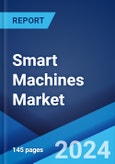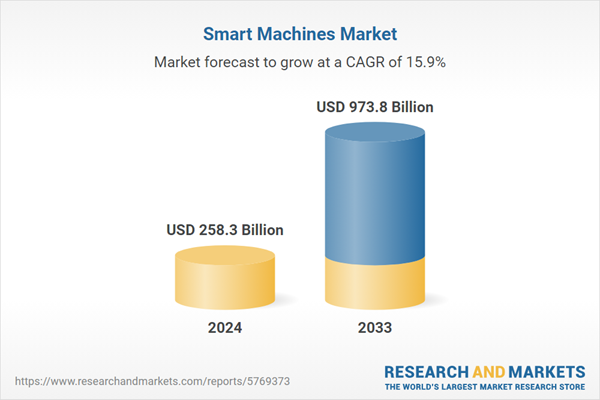Smart Machines Market Trends:
Ongoing Advancements in artificial intelligence (AI)The rapid progress in AI technologies, including machine learning, natural language processing, and computer vision, is a significant driver in various industries. Smart machines are leveraging these AI capabilities to analyze vast amounts of data, make autonomous decisions, and perform tasks with unparalleled efficiency and accuracy. In healthcare, AI assists in diagnosing diseases and optimizing treatment plans, improving patient outcomes. In finance, AI-driven algorithms enhance fraud detection and trading strategies. Furthermore, AI-powered chatbots and virtual assistants enhance customer service and support in the service sector. The potential applications span across sectors such as manufacturing, retail, and logistics, streamlining operations and reducing costs. As AI continues to evolve and mature, its impact on productivity, innovation, and competitiveness is reshaping industries worldwide. Additionally, AI-driven predictive analytics is transforming businesses by providing valuable insights for better decision-making, resource allocation, and risk management. Furthermore, as AI technologies become more accessible and affordable, their adoption is democratizing innovation, enabling even smaller enterprises to harness the benefits of intelligent automation and data-driven solutions.
Rising automation and efficiency demands
The rising need for automation and improved operational efficiency is another major driver in various industries such as manufacturing, logistics, and healthcare. Smart machines, enabled by advanced automation technologies, offer the capability to streamline complex processes, reduce human intervention, and enhance overall productivity. In manufacturing, automation systems optimize production lines, resulting in higher output, reduced errors, and lower labor costs. In logistics and supply chain management, AI-powered solutions enhance route optimization, inventory management, and order fulfillment, leading to significant cost savings and improved delivery times. Additionally, the healthcare sector benefits from automation in patient data management, appointment scheduling, and robotic surgeries, enhancing patient care and resource utilization. This growing demand for automation and efficiency is accelerating the adoption of smart machines, transforming industries and enabling them to stay competitive in an increasingly fast-paced and data-driven business environment. Furthermore, the continuous pursuit of cost-effectiveness and competitiveness in today's global market landscape is encouraging organizations to embrace automation and efficiency-driven solutions, solidifying the role of smart machines as indispensable tools for modern business operations.Enhanced customer experiences
The growing demand for personalized and intelligent customer experiences is a pivotal driver behind the adoption of smart machines across numerous sectors, including retail, hospitality, and customer service. Smart machines, empowered by AI and data analytics, can analyze vast amounts of customer data, enabling them to provide tailored product recommendations, personalized services, and responsive interactions. In the retail industry, AI-driven chatbots and recommendation engines enhance the shopping experience, leading to higher customer satisfaction and increased sales. Similarly, in the hospitality sector, smart machines can optimize room bookings, offer personalized amenities, and improve guest interactions, fostering customer loyalty. This heightened focus on enhancing customer experiences solidifies brand reputation and drives business growth, as satisfied customers are more likely to return and recommend services to others in an increasingly competitive marketplace. Moreover, as consumers increasingly seek convenience and relevance in their interactions with businesses, the integration of smart machines in delivering personalized experiences has become a critical strategy for companies looking to thrive in the digital age.Smart Machines Industry Segmentation:
The publisher provides an analysis of the key trends in each segment of the market, along with forecasts at the global, regional, and country levels for 2025-2033. Our report has categorized the market based on component, machine type, technology, and application.Breakup by Component:
- Hardware
- Software
- Services
Software accounts for the majority of the market share
The report has provided a detailed breakup and analysis of the market based on the component. This includes hardware, software, and services. According to the report, software represented the largest segment.Breakup by Machine Type:
- Robots
- Autonomous Cars
- Drones
- Wearable Device
- Others
Robots hold the largest share in the industry
A detailed breakup and analysis of the market based on the machine type have also been provided in the report. This includes robots, autonomous cars, drones, wearable devices, and others. According to the report, robots accounted for the largest market share.Breakup by Technology:
- Cloud Computing Technology
- Big Data Technology
- Internet of Everything
- Robotics
- Cognitive Technology
- Affective Technology
Cloud computing technology represents the leading market segment
The report has provided a detailed breakup and analysis of the market based on the technology. This includes cloud computing technology, big data technology, internet of everything, robotics, cognitive technology, and affective technology. According to the report, cloud computing technology represented the largest segment.Breakup by Application:
- Automotive
- Consumer Electronics
- Healthcare
- Industrial
- Logistics and Transportation
- Military, Aerospace and Defense
- Security
Consumer electronics holds the largest share in the industry
A detailed breakup and analysis of the market based on the application have also been provided in the report. This includes automotive, consumer electronics, healthcare, industrial, logistics and transportation, military, aerospace and defense, and security. According to the report, consumer electronics accounted for the largest market share.Breakup by Region:
- North America
- United States
- Canada
- Europe
- Germany
- France
- United Kingdom
- Italy
- Spain
- Russia
- Others
- Asia Pacific
- China
- Japan
- India
- South Korea
- Australia
- Indonesia
- Others
- Latin America
- Brazil
- Mexico
- Others
- Middle East and Africa
Asia Pacific leads the market, accounting for the largest smart machines market share
The market research report has also provided a comprehensive analysis of all the major regional markets, which include North America (the United States and Canada); Europe (Germany, France, the United Kingdom, Italy, Spain, Russia, and others); Asia Pacific (China, Japan, India, South Korea, Australia, Indonesia, and others); Latin America (Brazil, Mexico, and others); and the Middle East and Africa. According to the report, Asia Pacific accounted for the largest market share.The market research report has provided a comprehensive analysis of the competitive landscape. Detailed profiles of all major companies have also been provided.
Some of the key players in the market include:
- ABB Ltd
- Apple Inc.
- BAE Systems plc
- General Electric Company
- Google LLC (Alphabet Inc.)
- International Business Machines Corporation
- KUKA AG (Midea Group Co. Ltd.)
- LG Electronics Inc.
- Microsoft Corporation
- Smarsh Inc.
Key Questions Answered in This Report:
- How has the global smart machines market performed so far, and how will it perform in the coming years?
- What are the drivers, restraints, and opportunities in the global smart machines market?
- What is the impact of each driver, restraint, and opportunity on the global smart machines market?
- What are the key regional markets?
- Which countries represent the most attractive smart machines market?
- What is the breakup of the market based on the component?
- Which is the most attractive component in the smart machines market?
- What is the breakup of the market based on the machine type?
- Which is the most attractive machine type in the smart machines market?
- What is the breakup of the market based on technology?
- Which is the most attractive technology in the smart machines market?
- What is the breakup of the market based on the application?
- Which is the most attractive application in the smart machines market?
- What is the competitive structure of the market?
- Who are the key players/companies in the global smart machines market?
Table of Contents
Companies Mentioned
- ABB Ltd
- Apple Inc.
- BAE Systems plc
- General Electric Company
- Google LLC (Alphabet Inc.)
- International Business Machines Corporation
- KUKA AG (Midea Group Co. Ltd.)
- LG Electronics Inc.
- Microsoft Corporation
- Smarsh Inc.
Methodology

LOADING...
Table Information
| Report Attribute | Details |
|---|---|
| No. of Pages | 147 |
| Published | March 2025 |
| Forecast Period | 2024 - 2033 |
| Estimated Market Value ( USD | $ 258.3 Billion |
| Forecasted Market Value ( USD | $ 973.8 Billion |
| Compound Annual Growth Rate | 15.9% |
| Regions Covered | Global |
| No. of Companies Mentioned | 10 |









